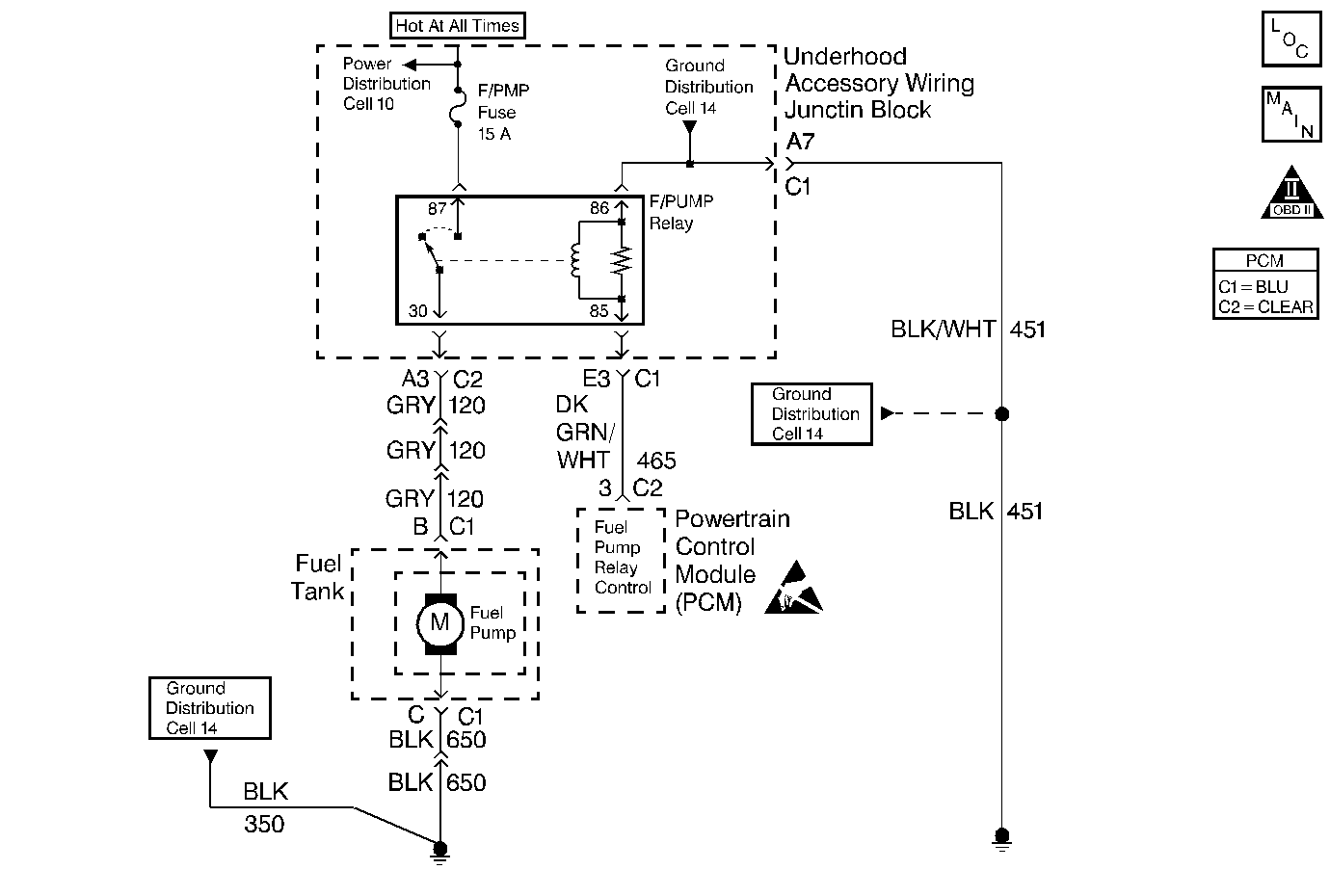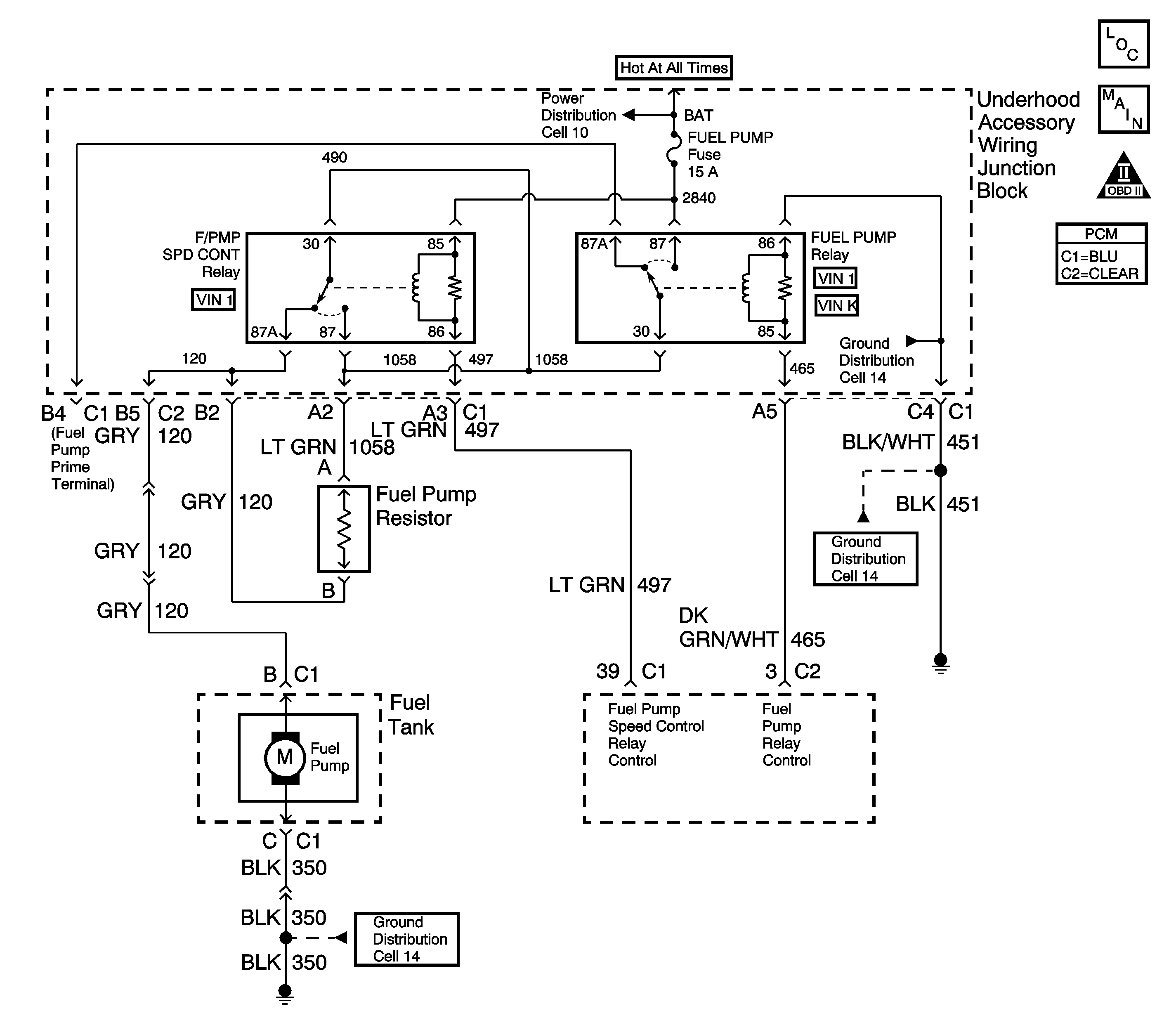Fuel Pump Electrical Circuit Diagnosis VIN K

Circuit Description
When the ignition switch is first turned on , the PCM energizes the fuel pump relay which applies power to the in-tank fuel pump. The fuel pump relay will remain on as long as the engine is running or cranking and the PCM is receiving reference pulses. If no reference pulses are present, the PCM de-energizes the fuel pump relay within 2 seconds after the ignition is turned on or the engine is stopped.
The fuel pump delivers fuel to the fuel rail and injectors, then to the fuel pressure regulator. The fuel pressure regulator controls fuel pressure by allowing excess fuel to be returned to the fuel tank.
Diagnostic Aids
An intermittent may be caused by a poor connection, rubbed through wire insulation or a wire broken inside the insulation. Check for a poor connection or damaged harness. Inspect the PCM harness and connectors for the following items:
| • | Improper mating |
| • | Broken locks |
| • | Improperly formed or damaged terminals |
| • | Poor terminal to wire connections |
| • | Damaged harnesses |
Test Description
The numbers below refer to the step numbers on the Diagnostic Table:
-
Tests the ignition feed circuit to the fuel pump relay.
-
Verifies that the fuel pump feed circuit is OK between the fuel pump relay and the fuel pump, and that the fuel pump can deliver adequate pressure to the fuel rail.
-
Tests the fuel pump feed circuit for a short to battery positive voltage.
-
Tests whether the problem is being caused by an open in the fuel pump feed circuit or the fuel pump ground circuit.
Step | Action | Value(s) | Yes | No |
|---|---|---|---|---|
1 | Did you Perform the Powertrain On-Board Diagnostic (OBD) System Check? | -- | ||
Does the test lamp illuminate? | -- | |||
Caution: Wrap a shop towel around the fuel pressure connection in order to reduce the risk of fire and personal injury. The towel will absorb any fuel leakage that occurs during the connection of the fuel pressure gage. Place the towel in an approved container when the connection of the fuel pressure gage is complete. Does the pressure measure between the specified values. | 284-325 kPa (41-47 psi) | |||
Connect a test lamp between the fuel pump feed circuit at the fuel pump relay connector and a known good ground. Does the test lamp illuminate? | -- | |||
5 | Test the fuel pump feed circuit for a short to voltage. Refer to Wiring Repairs . Did you find and correct the condition? | -- | -- | |
6 |
Did you find and correct the condition? | -- | ||
7 | Repair the open or short to ground in the fuel pump relay switch feed circuit. Refer to Wiring Repairs . Did you find and correct the condition? | -- | -- | |
Does the test lamp illuminate? | -- | |||
9 |
Did you find and correct the condition? | -- | ||
10 | Repair the open in the fuel pump ground circuit. Refer to Wiring Repairs . Did you find and correct the condition? | -- | ||
11 | Replace the fuel pump relay. Did you complete the replacement? | -- | -- | |
12 | Repair the fuel pump harness for an external open or short between the fuel pump connector and the fuel pump. Refer to Wiring Repairs . Did you find and correct the condition? | -- | ||
13 | Replace the fuel pump. Refer to Fuel Sender Assembly Replacement . Did you complete the replacement? | -- | -- | |
14 |
Does the fuel pressure measure between the specified values? | 284-325 kPa (41-47 psi) | System OK |
Fuel Pump Electrical Circuit Diagnosis VIN 1

Circuit Description
When the Ignition switch is first turned ON, the PCM energizes the fuel pump relay which applies power to the fuel pump through the high speed circuit (controlled by the fuel pump speed control relay). The fuel pump relay will remain ON as long as the engine is running or cranking and the PCM is receiving reference pulses. If no reference pulses are present, the PCM de-energizes the fuel pump relay within 2 seconds after the ignition is turned ON or the engine is stopped. The fuel pump delivers fuel to the fuel rail and injectors, then to the fuel pressure regulator. The fuel pressure regulator controls fuel pressure by allowing excess fuel to be returned to the fuel tank. With the engine stopped, the fuel pump can be turn ON by using the scan tool output controls function.
The PCM alters fuel pump speed by energizing the fuel pump speed control relay Under normal conditions, the fuel pump control speed control relay is energized (normal fuel pump speed). The applied voltage to the fuel pump is controlled by a resistor assembly. When higher fuel volume is required due to increased engine load (MAP sensor value over 90 kPa). the PCM de-energizes the fuel pump speed control relay circuit. The increased voltage to the in-tank fuel pump allows a higher volume of fuel to be delivered to the fuel rail. The PCM also compensates for low system voltage by energizing the fuel pump speed control relay.
Diagnostic Aids
An intermittent may be caused by a poor connection, rubbed through the wire insulation or a wire broken inside of the insulation.
Check for a poor connection or a damaged harness. Inspect the PCM harness and connectors for the following items:
| • | Improper mating |
| • | Broken locks |
| • | Improperly formed or damaged terminals |
| • | Poor terminal to wire connections |
| • | Damaged harnesses |
Test Description
Number(s) below refer to the step number(s) on the Diagnostic Table:
-
The fuel pump primes the fuel rail/injectors using the high speed circuit. This check ensures proper fuel pressure for the vehicle to start.
-
Checks for a short to ground in the feed circuit to the fuel pump relay.
-
Tests for continuity from the fuel pump relay to the fuel pump ground.
-
Tests for a short to ground in the feed circuit or speed control resistor circuit to the fuel pump.
-
Tests the fuel pump resistor and resistor pigtail for a short to ground.
-
Tests the continuity of the speed control and fuel pump feed harness/splices.
Step | Action | Value(s) | Yes | No | ||||||
|---|---|---|---|---|---|---|---|---|---|---|
1 | Did you preform the Powertrain On-Board Diagnostic (OBD) System Check? | -- | ||||||||
2 | Did DTC P0230 or DTC 1260 set? | -- | Go to DTC P0230 Fuel Pump Relay Control Circuit or DTC P1260 Fuel Pump Speed Relay Control Circuit | |||||||
|
Caution: Wrap a shop towel around the fuel pressure connection in order to reduce the risk of fire and personal injury. The towel will absorb any fuel leakage that occurs during the connection of the fuel pressure gage. Place the towel in an approved container when the connection of the fuel pressure gage is complete.
Is proper fuel pressure indicated? | 333-376 kPa (48-55 psi) | |||||||||
4 |
Did the fuel pressure drop? | -- | ||||||||
|
Important: If the engine cranks but will not run, continue with the Engine Cranks but Does Not Start diagnostic table.
Is proper fuel pressure indicated? | 333-376 kPa (48-55 psi) | |||||||||
6 | Test for a blown fuel pump fuse. Is the fuse blown? | -- | ||||||||
Is the test lamp on? | -- | |||||||||
Is the test lamp ON? | -- | |||||||||
9 | Locate and repair short between the following circuits. Refer to Wiring Repairs .
Is the action complete? | -- | ||||||||
10 |
Did the fuse blow? | -- | ||||||||
11 |
Is proper fuel pressure indicated? | -- | ||||||||
Reconnect the fuel pump resistor harness. Did the fuse blow? | -- | |||||||||
13 | Locate and repair a short to B+ in the following locations. Refer to Wiring Repairs .
Did you find and correct the condition? | -- | -- | |||||||
14 | Check for an open or short to ground in the fuel pump driver circuit in the under hood accessory wiring junction block. Refer to Wiring Repairs , Repairing Connector Terminals or Intermittents and Poor Connections Diagnosis . Did you find and correct the condition? | -- | -- | |||||||
15 |
Is the test lamp ON? | -- | ||||||||
Is proper fuel pressure indicated? | -- | |||||||||
17 | Locate and repair open or short in the B+ feed to the fuel pump relay. Refer to Wiring Repairs . Is action complete? | -- | -- | |||||||
18 |
Was a problem found? | -- | ||||||||
19 |
Was a problem found? | -- | ||||||||
20 | Check for an open fuel pump speed control resistor. Was a problem found? | -- | ||||||||
21 |
Is the test lamp ON? | -- | ||||||||
22 |
Was a problem found? | -- | ||||||||
23 | Connect the test lamp between terminal C in the fuel pump connector and chassis ground. Is the test lamp ON? | -- | ||||||||
24 | Locate and repair open or poor terminal connection in the fuel pump ground circuit. Refer to Repairing Connector Terminals . Is the action complete? | -- | -- | |||||||
25 | Locate and repair open or poor terminal connections in the following circuits: Refer to Repairing Connector Terminals
Is the action complete? | -- | -- | |||||||
26 | Replace the fuel pump speed control resistor. Refer to Fuel Pump Resistor Replacement . Is action complete? | -- | -- | |||||||
27 |
Did you find and correct the condition? | -- | ||||||||
28 | Replace the pump. Refer to Fuel Sender Assembly Replacement . Is action complete? | -- | -- | |||||||
29 | Replace the fuel pump relay. Refer to Fuel Pump Relay Replacement Is action complete? | -- | -- | |||||||
30 | Replace the fuel pump speed control relay Is action complete? | -- | -- | |||||||
31 |
Is proper fuel pressure indicated? | 333-376 kPa (48-55 psi) | ||||||||
32 |
Does the fuel pressure increase slightly when high fuel pump speed is selected? | -- | System OK |
